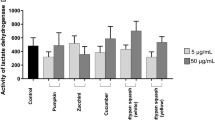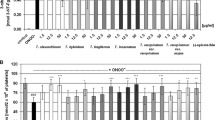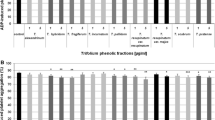Abstract
Red cabbage belongs to cruciferous vegetables recognized as a rich source of anthocyanins. Anthocyanins have a wide range of therapeutic advantages without adverse effects, including cardiovascular protective properties. For development of cardiovascular diseases, platelet activation is crucial; therefore compounds which inhibit platelet activation are sought after. The anti-platelet activity of anthocyanins has only been described and is still unclear. In our study, the extract of anthocyanins, obtained from fresh leaves of red cabbage, was used in vitro to examine their antioxidative effects on platelets under oxidative stress conditions which are responsible for hyperactivity of these cells. The antiplatelet and antioxidative activities were determined by platelet aggregation and specific markers of the arachidonate cascade with O −·2 generation, and oxidative changes (carbonyl groups and 3-nitrotyrosine). Extracts (5–15 μM) protected platelet proteins and lipids against oxidative damage, and diminished platelet activation. Anthocyanins from red cabbage provided beneficial anti-platelet effects and might help prevent cardiovascular diseases.
Similar content being viewed by others
References
Mazza G., Miniati E., Anthocyanins in fruits, vegetables, and grains, Ann Arbor Press, Boca Raton, London, Tokyo, 199
Charron C.S., Clevidence B.A., Britz S.J., Novotny J.A., Effect of dose size on bioavailability of acylated and nonacylated anthocyanins from red cabbage (Brassica oleracea L. Var. capitata), J. Agric. Food Chem., 2007, 55, 5354–5362
Valcheva-Kuzmanova S., Kuzmanov K., Mihova V., Krasnaliev I., Borisova P., Belcheva A., Antihyperlipidemic effect of Aronia melanocarpa fruit juice in rats fed a high-cholesterol diet, Plant Foods Hum. Nutr., 2007, 62, 19–24
Wu X., Beecher G.R., Holden J.M., Haytowitz D.B., Gebhardt S.E., Prior R.L., Concentrations of anthocyanins in common foods in the United States and estimation of normal consumption, J. Agric. Food Chem., 2006, 54, 4069–4075
Shapiro A.D., Platelet function disorders, Haemophilia., 2000, 6, 120–127
Elahi M.M., Kong Y.X., Matata B.M., Oxidative stress as a mediator of cardiovascular disease, Oxid. Med. Cell Longev., 2009, 2, 259–269
Tammy M.B., Dietary antioxidants and assessment of oxidative stress, Nutrition, 2000, 16, 578–581
Jane E., Freedman M.D., Molecular regulation of platelet-dependent thrombosis, Circulation, 2005, 112, 2725–2734
Krotz F., Sohn H.Y., Pohl U., Reactive oxygen species: players in the platelet game, Arterioscler. Thromb. Vasc. Biol., 2004, 24, 1988–1996
Wachowicz B., Kustron J., Effect of cisplatin on lipid peroxidation in pig blood platelets, Cytobios., 1992, 70, 41–47
Walkowiak B., Michalak E., Koziolkiewicz W., Cierniewski C.S., Rapid photometric method for estimation of platelet count in blood plasma or platelet suspension, Thromb. Res., 1989, 56, 763–766
Pryor W.A., Cueto R., Jin X., Koppenol W.H., Ngu-Schwemlein M., Squadrito G., et al., A practical method for preparing peroxynitrite solutions of low ionic strength and free of hydrogen peroxide, Free Radic. Biol. Med., 1991, 1, 75–83
Gitz D.C., Liu L., McClure L., Phenolic metabolism, growth, and UV-B tolerance in phenylalanine ammonialyase inhibited red cabbage seedlings, Phytochem., 1998, 49, 377–386
Dyrby M., Westergaard N., Stapelfeldt H., Light and heat sensitivity of red cabbage extract in soft drink model system, Food. Chem., 2001, 72, 431–437
Podsedek A., Sosnowska D., Redzynia M., Anders B., Antioxidant capacity and content of Brasica oleracea dietary antioxidants, Int. J. Food. Sci. Technol., 2006, 41, 49–58
Wachowicz B., Adenine nucleotides in thrombocytes of birds, Cell Biochem. Funct., 1984, 2, 167–170
Jahn B., Hansch G.M., Oxygen radical generation in human platelets: dependence on 12-lipoxygenase activity and on the glutathione cycle, Int. Arch. Allergy Appl. Immunol., 1990, 93, 73–79
Nowak P., Wachowicz B., Peroxynitrite-mediated modification of fibrinogen affects platelet aggregation and adhesion, Platelets, 2002, 13, 293–299
Buss H., Chan T.P., Sluis K.B., Domigan N.M., Winterbourn C.C., Protein carbonyl measurement by a sensitive ELISA method, Free Radic. Biol. Med., 1997, 23, 361–366
Levine R.L., Carbonyl modified proteins in cellular regulation, aging, and disease, Free Radic. Biol. Med., 2002, 32, 790–796
Khan J., Brennand D.M., Bradley N., Gao B., Bruckdorfer R., Jacobs M., 3-Nitrotyrosine in the proteins of human plasma determined by an ELISA method, Biochem. J., 1998, 330, 795–801
World Health Organization (W.H.O.), Cardiovascular diseases (CVDs), Fact sheet No 317, 2010
Allender S., Scarborough P., Peto V., Rayner M., Leal J., Luengo-Fernandez R., et al., European Cardiovascular Disease Statistics, 3rd ed, European Heart Network, London, 2008
Dauchet L., Amouyel P., Dallongeville J., Fruits, vegetables and coronary heart disease, Nat. Rev. Cardiol., 2009, 6, 599–608
Arts I.C., Hollman P.C., Polyphenols and disease risk in epidemiologic studies, Am. J. Clin. Nutr., 2005, 81, 317–325
Rice-Evans C.A., Miller N.J., Paganga G., Structure-antioxidant activity relationships of flavonoids and phenolic acids, Free Radic. Biol. Med., 1996, 20, 933–956
Pollard S.E., Kuhnle G.G., Vauzour D., Vafeiadou K., Tzounis X., Whiteman M. et al., The reaction of flavonoid metabolites with peroxynitrite, Biochem. Biophys. Res. Commun., 2006, 350, 960–968
Chun O.K., Chung S.J., Song W.O., Estimated dietary flavonoid intake and major food sources of U.S. adults, J. Nutr., 2007, 137, 1244–1252
Kołodziejczyk J., Saluk-Juszczak J., Posmyk M.M., Janas K.M., Wachowicz B., Red cabbage anthocyanins may protect blood plasma proteins and lipids, Cent. Eur. J. Biol., 2011, 6, 565–574
McDougall G.J., Fyffe S., Dobson P., Stewart D., Anthocyanins from red cabbage—stability to simulated gastrointestinal digestion, Phytochemistry, 2007, 68, 1285–1294
Karlsen A., Retterstol L., Laake P., Paur I., Kjolsrud-Bohn S., Sandvik L. et al., Anthocyanins inhibit nuclear factor-kappaB activation in monocytes and reduce plasma concentrations of pro-inflammatory mediators in healthy adults, J. Nutr., 2007, 137, 1951–1954
Williams R.J., Spencer J.P., Rice-Evans C., Flavonoids: antioxidants or signalling molecules?, Free Radic. Biol. Med., 2004, 36, 838–849
Mazza G., Kay C.D., Cottrell T., Holub B.J., Absorption of anthocyanins from blueberries and serum antioxidant status in human subjects, J. Agric. Food Chem., 2002, 50, 7731–7737
Kay C.D., Aspects of anthocyanin absorption, metabolism and pharmacokinetics in humans, Nutr. Res. Rev., 2006, 19, 137–146
Kalt W., Blumberg J.B., McDonald J.E., Vinqvist-Tymchuk M.R., Fillmore S.A., Graf B.A., et al., Identification of anthocyanins in the liver, eye, and brain of blueberry-fed pigs, J. Agric. Food Chem., 2008, 56, 705–712
Radi R., Peroxynitrite reactions and diffusion in biology, Chem. Res. Toxicol., 1998, 11, 720–721
Young I.S., McEneny J., Lipoprotein oxidation and atherosclerosis, Biochem. Soc. Trans., 2001, 29, 358–362
Harrison D., Griendling K.K., Landmesser U., Hornig B., Drexler H., Role of oxidative stress in atherosclerosis, Am. J. Cardiol., 2003, 91, 7A–11A
Niki E., Yamamoto Y., Komuro E., Sato K., Membrane damage due to lipid oxidation, Am. J. Clin. Nutr., 1991, 53, 201S–205S
Kaneko T., Tahara S., Baba N., Inhibition of linoleic acid hydroperoxide-induced toxicity in cultured human fibroblasts by anthocyanidins, Biosci. Biotechnol. Biochem., 2003, 67, 1391–1393
Kahkonen M.P., Heinonen M., Antioxidant activity of anthocyanins and their aglycons, J. Agric. Food Chem., 2003, 51, 628–633
Marnett L.J., Lipid peroxidation-DNA damage by malondialdehyde, Mutat. Res., 1999, 424, 83–95
Yang X., Yang L., Zheng H., Hypolipidemic and antioxidant effects of mulberry (Morus alba L.) fruit in hyperlipidaemia rats, Food Chem. Toxicol., 2010, 48, 2374–2379
Burdan F., Chalas A., Szumilo J., Cyclooxygenase and prostanoids—biological implications, Postepy Hig. Med. Dosw., 2006, 60, 129–141 (in Polish)
Wachowicz B., Olas B., Zbikowska H.M., Buczynski A., Generation of reactive oxygen species in blood platelets, Platelets, 2002, 13, 175–182
Lusis A.J., Atherosclerosis, Nature, 2000, 407, 233–241
Author information
Authors and Affiliations
Corresponding author
About this article
Cite this article
Saluk, J., Bijak, M., Kołodziejczyk-Czepas, J. et al. Anthocyanins from red cabbage extract — evidence of protective effects on blood platelets. cent.eur.j.biol. 7, 655–663 (2012). https://doi.org/10.2478/s11535-012-0057-9
Received:
Accepted:
Published:
Issue Date:
DOI: https://doi.org/10.2478/s11535-012-0057-9




